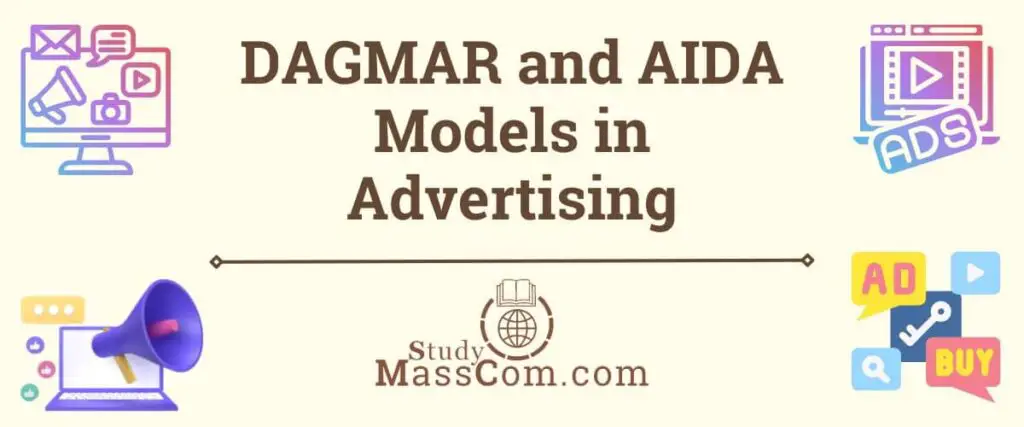DAGMAR and AIDA Models in Advertising
Introduction
In the dynamic world of advertising, marketers are constantly seeking effective strategies to communicate their brand messages and persuade consumers to take desired actions. Two popular models that have stood the test of time are the DAGMAR and AIDA models. These frameworks provide valuable guidance for crafting successful advertising campaigns, enabling businesses to drive awareness, generate interest, and ultimately convert potential customers into loyal brand advocates. In this article, we will delve into the essence of the DAGMAR and AIDA models, exploring their key principles and how they can be applied in today’s advertising landscape.

DAGMAR Model: Definition & Meaning
DAGMAR, an acronym for Defining Advertising Goals for Measured Advertising Results, focuses on setting specific, measurable objectives for advertising campaigns. The model emphasizes the importance of precise goal-setting and accountability.
Let’s explore its key elements:
Defining Objectives
DAGMAR requires marketers to establish precise and quantifiable advertising objectives, such as increasing brand awareness by a certain percentage, generating a specific number of leads, or achieving a target sales volume. Clear objectives provide direction and enable evaluation of campaign effectiveness.
Establishing Benchmarks
Before launching an advertising campaign, it is crucial to establish baseline measurements that serve as benchmarks for evaluating progress. These benchmarks can include current sales figures, brand awareness levels, or customer perception. By comparing results against these benchmarks, marketers can assess the impact of their advertising efforts.
Implementing Communication Tasks
DAGMAR emphasizes the identification of specific communication tasks necessary to achieve the set objectives. This involves determining the target audience, selecting appropriate media channels, crafting persuasive messages, and allocating resources effectively.
Measurement and Evaluation
Measuring and evaluating the outcomes of advertising campaigns is a critical aspect of the DAGMAR model. Regular monitoring and analysis of key performance indicators allow marketers to gauge the success of their efforts and make necessary adjustments. By comparing actual results with predetermined objectives, they can identify areas of improvement and refine future campaigns.
AIDA Model: Definition & Meaning
The AIDA model, an acronym for Attention, Interest, Desire, and Action, has long been recognized as a fundamental framework for advertising.
Let’s break down each stage of the AIDA model:
A – Attention
The first step is to capture the audience’s attention through compelling headlines, visually appealing ads, or captivating storytelling. This stage aims to create awareness and interrupt the consumer’s current thought process.
I – Interest
Once attention is secured, the next goal is to spark interest in the product or service. Marketers should highlight unique selling points, demonstrate benefits, and establish an emotional connection with the audience. Providing relevant information that addresses consumer needs and desires is key to maintaining interest.
D – Desire
Having piqued the interest of potential customers, the next stage is to intensify their desire for the product or service. This can be achieved by showcasing how it fulfills their aspirations, solving their problems, or enhancing their lives. Emotional appeals, testimonials, and social proof can play a vital role in building desire.
A – Action
The final stage of the AIDA model is to guide consumers toward taking action. Whether it’s making a purchase, signing up for a newsletter, or requesting more information, the call-to-action (CTA) must be clear, compelling, and easily accessible. Encouraging urgency or offering incentives can further motivate the audience to act.
DAGMAR and AIDA Models: Advantages & Disadvantages
Advantages of the DAGMAR Model
Goal-oriented Approach
The DAGMAR model emphasizes the importance of setting specific and measurable objectives for advertising campaigns. This allows marketers to define clear targets and align their strategies accordingly, increasing the chances of achieving desired outcomes.
Accountability and Evaluation
By establishing benchmarks and measuring campaign results against predetermined objectives, the DAGMAR model enables marketers to assess the effectiveness of their advertising efforts. This data-driven approach provides valuable insights for making informed decisions and optimizing future campaigns.
Efficient Resource Allocation
The model encourages marketers to allocate resources based on the defined objectives and desired outcomes. By focusing on specific communication tasks, they can allocate budgets, select appropriate media channels, and craft messages that are aligned with the campaign’s goals.
Disadvantages of the DAGMAR Model
Complex Measurement
While the DAGMAR model emphasizes the importance of measurement and evaluation, accurately measuring the impact of advertising on consumer behavior can be challenging. Attribution of results solely to advertising efforts may not always be straightforward, as other factors such as market conditions and competitive activities can influence outcomes.
Narrow Focus
The DAGMAR model primarily focuses on communication objectives and may not encompass broader marketing objectives or factors such as brand perception, customer loyalty, or long-term impact. It may overlook the holistic nature of marketing strategies that extend beyond advertising alone.
Advantages of the AIDA Model
Clear Progression
The AIDA model provides a logical and sequential framework for guiding consumers from initial attention to taking action. It helps marketers structure their messaging and ensure that each stage of the consumer journey is addressed effectively.
Emotional Appeal
The model recognizes the importance of emotional connection in advertising. By addressing consumer desires, aspirations, and pain points, marketers can create compelling narratives that resonate with their target audience and drive engagement.
Flexibility
The AIDA model can be applied across various advertising channels and formats, from print and television to digital and social media. It offers marketers the flexibility to adapt their strategies to different platforms while following the core principles of attention, interest, desire, and action.
Disadvantages of the AIDA Model
Oversimplification
While the AIDA model provides a useful framework, it oversimplifies the complexities of consumer behavior. In reality, the consumer journey is often non-linear, and individuals may skip stages or revisit them multiple times before making a decision.
Lack of Interactivity
In today’s digital age, consumers expect personalized and interactive experiences. The AIDA model primarily focuses on one-way communication, which may not fully leverage the potential of two-way engagement and interactivity offered by digital platforms.
It’s worth noting that both models have their strengths and weaknesses, and marketers can adapt and combine elements of these frameworks to suit their specific needs and the evolving advertising landscape.
Difference Between DAGMAR and AIDA model
The AIDA and DAGMAR models are two distinct frameworks used in advertising, differing in their approach and focus. Here are the key differences between them:
Focus and Purpose
DAGMAR Model: The DAGMAR model emphasizes the importance of setting specific, measurable objectives for advertising campaigns. Its purpose is to define advertising goals, establish benchmarks, implement communication tasks, and measure results to evaluate the effectiveness of advertising efforts.
AIDA Model: The AIDA model focuses on guiding consumers through a sequential process of attention, interest, desire, and action. Its purpose is to capture attention, generate interest, build desire, and ultimately drive consumers to take a specific action, such as making a purchase or requesting more information.
Structure
DAGMAR Model: The DAGMAR model is more structured in terms of goal-setting and measurement. It involves defining precise objectives, establishing benchmarks, implementing communication tasks, and measuring outcomes against predetermined goals.
AIDA Model: The AIDA model provides a step-by-step progression for consumer engagement, outlining the stages from capturing attention to driving action. It focuses on creating an emotional connection with the audience and gradually guiding them toward a desired response.
Scope
DAGMAR Model: The DAGMAR model takes a broader perspective by emphasizing goal-setting, accountability, and measurement. It involves defining objectives beyond communication, such as increasing brand awareness, generating leads, or achieving sales targets. It also considers factors like audience targeting, media selection, and resource allocation.
AIDA Model: The AIDA model is primarily concerned with the communication aspect of advertising and how to effectively move consumers through the stages of attention, interest, desire, and action. It focuses on crafting persuasive messages and engaging storytelling to capture consumer interest and motivate them to take action.
Flexibility
DAGMAR Model: The DAGMAR model provides a systematic approach for planning and evaluating advertising campaigns. It focuses on setting specific objectives and establishing measurable benchmarks, which helps in efficient resource allocation and evaluating the effectiveness of advertising efforts.
AIDA Model: The AIDA model is flexible and can be applied across different advertising channels and formats, allowing marketers to adapt their strategies to various platforms while following the core principles of attention, interest, desire, and action.
In summary, the AIDA model is a sequential framework that guides the progression of consumer attention, interest, desire, and action, while the DAGMAR model focuses on setting precise objectives, implementing communication tasks, and measuring results to evaluate the effectiveness of advertising campaigns. Both models offer valuable insights and can be utilized in conjunction to create comprehensive and impactful advertising strategies.
Conclusion
The DAGMAR and AIDA models offer valuable frameworks for marketers to create effective advertising campaigns. The AIDA model guides the progression of consumer attention, interest, desire, and action, while the DAGMAR model emphasizes goal-setting, accountability, and measurement. By incorporating these models into their advertising strategies, businesses can enhance their ability to connect with consumers, drive brand engagement, and achieve desired outcomes.
FAQs
The AIDA model is a classic marketing framework that describes the stages a consumer goes through when interacting with a product or service. AIDA stands for Attention, Interest, Desire, and Action. Here’s how it is typically used:
1. Attention: This stage aims to capture the consumer’s attention through various means, such as compelling advertisements, eye-catching visuals, or attention-grabbing headlines. The goal is to create awareness and draw potential customers in.
2. Interest: Once the consumer’s attention is captured, the next step is to generate interest in the product or service. Marketers often provide more detailed information, highlight benefits, or share unique selling propositions to keep the consumer engaged and curious.
3. Desire: In this stage, the marketer seeks to cultivate a strong desire or preference for the product or service. They may use persuasive techniques, testimonials, customer reviews, or comparative advertising to convince the consumer that their offering is the best choice.
4. Action: The final stage of the AIDA model aims to prompt the consumer to take action, such as making a purchase, requesting more information, or subscribing to a newsletter. Marketers employ clear call-to-action statements and make the process as easy and straightforward as possible.
By understanding and applying the AIDA model, marketers can design their campaigns to guide consumers through these stages and ultimately achieve their marketing objectives.
The AIDA model is important in marketing for several reasons:
1. Structured approach: The AIDA model provides a structured framework for marketers to plan and execute their marketing strategies. It helps them understand the sequential steps a consumer typically goes through and guides them in designing effective communication and promotional activities.
2. Customer-centric perspective: AIDA places emphasis on the consumer’s journey and mindset. By considering the stages of attention, interest, desire, and action, marketers can align their messaging and tactics to address the needs, preferences, and motivations of their target audience. This customer-centric approach improves the effectiveness of marketing efforts.
3. Conversion optimization: AIDA helps marketers optimize their conversion rates by breaking down the process into manageable stages. By addressing each stage effectively, marketers can move consumers closer to the desired action, whether it’s making a purchase, signing up for a service, or taking another specific action that aligns with their objectives.
4. Message effectiveness: The AIDA model helps marketers craft compelling and relevant messages for different stages of the consumer journey. By understanding what captures attention, generates interest, creates desire, and prompts action, marketers can create impactful content that resonates with their audience and elicits the desired response.
5. Measurement and evaluation: The AIDA model provides a basis for measuring and evaluating marketing campaigns. It allows marketers to assess the effectiveness of their efforts at each stage, identify areas of improvement, and make data-driven decisions to optimize their strategies for better results.
Overall, the AIDA model serves as a valuable tool in marketing as it guides marketers in creating customer-focused strategies, optimizing conversions, and improving the overall effectiveness of their communication and promotional activities.


